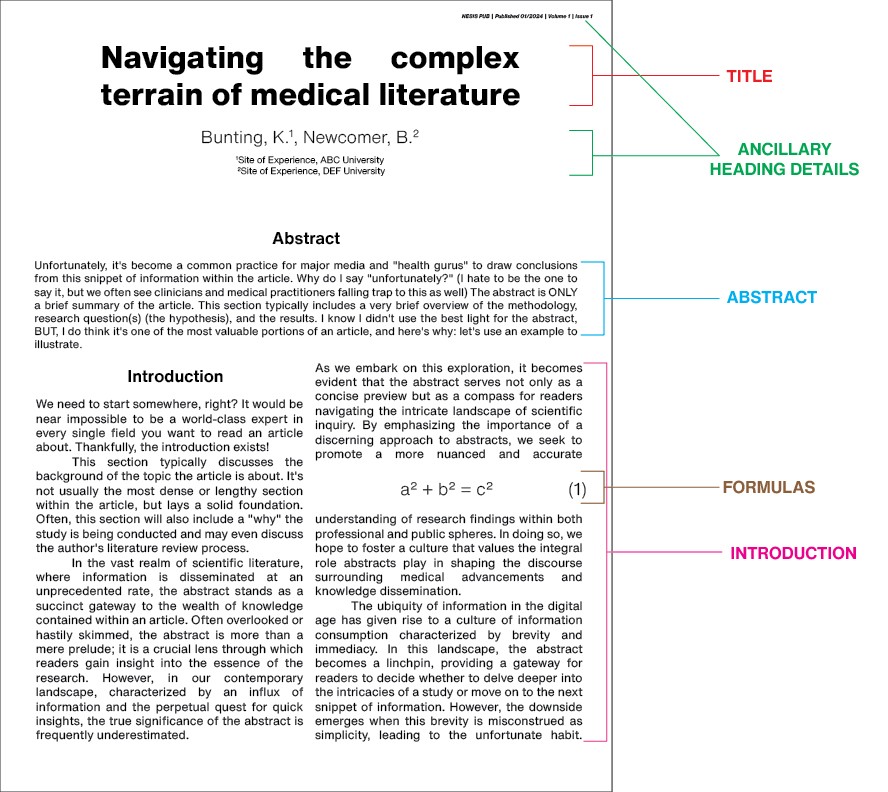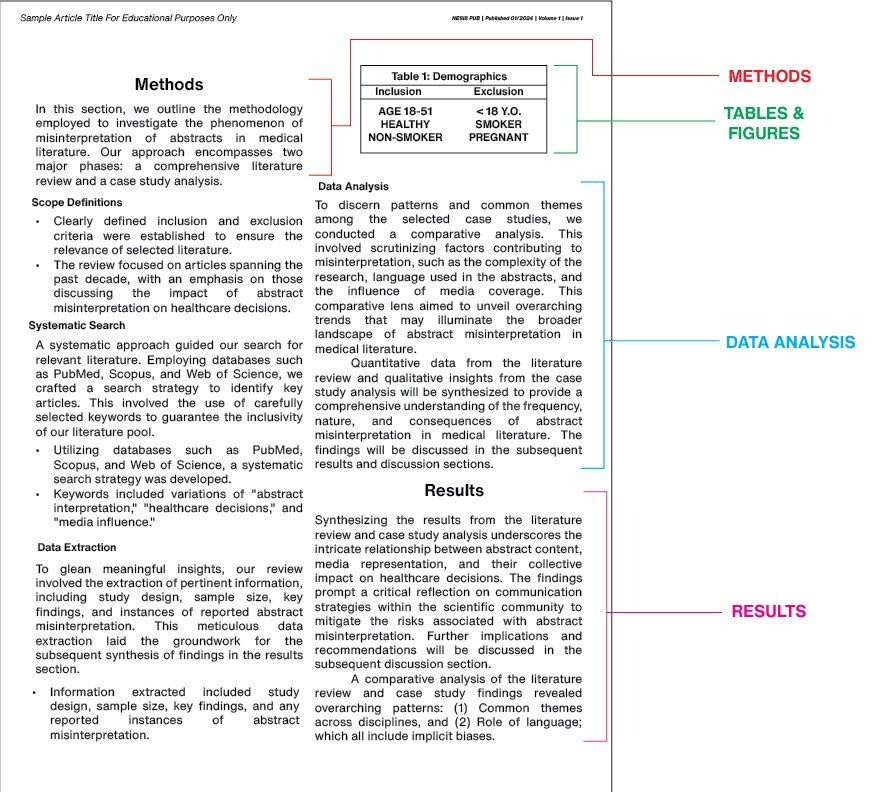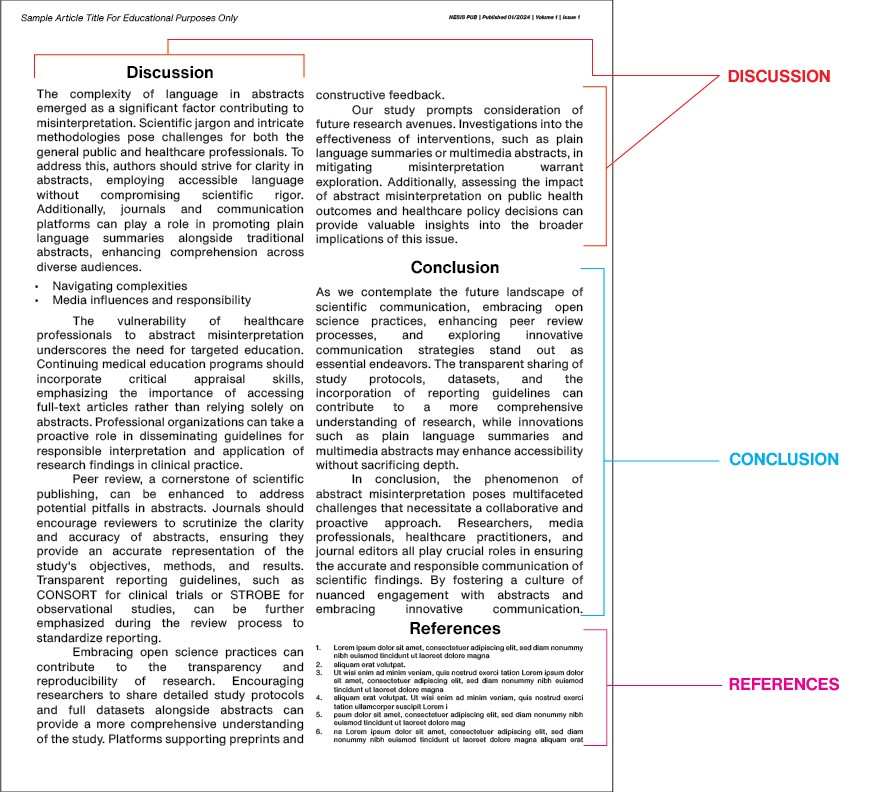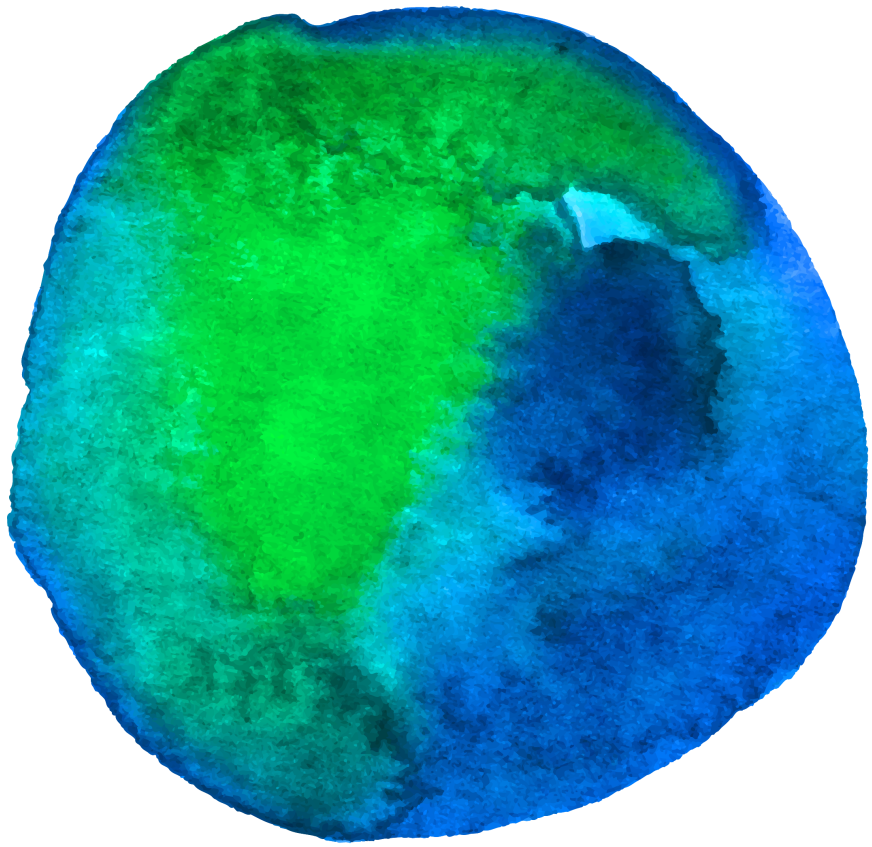Navigating Medical Literature Part I: Anatomy of a Journal Article

- written by Dr. Kevin Bunting Jr., PharmD (10-15 minute read)
All content in this post is for educational purposes only. Any content that aligns or matches any other sources is mere coincidence. All titles, examples and figures are made up and intentionally a little silly for demonstration purposes only.
For many, the idea of analyzing peer-reviewed articles can be a bit intimidating. It's not an intuitive skillset by any means.
I decided that I wanted to create a multi-part series to serve as a quick reference guide to analyzing some key items within peer-reviewed journal articles (i.e. what are the main sections of a journal article, what is a confidence interval? how do I know if a result shows statistical significant vs clinical significance, etc.).
Overview and what to expect:
-
Part I: Anatomy of a Journal Article (where you are right now)
-
Part II: Critical Statistical Components to Understand (where you are going next)
It is not my goal to make everyone reading this a complete clinical expert. Trust me, it takes years of practice to develop a strong process for evaluating scientific scholarly journal articles.
It is my goal to make everyone reading this a bit more comfortable in reading and evaluating what you hear and see around you regarding the health and wellness space. I'd like you to be able to see a headline on social media or on the news and be able to ask appropriate questions to determine its validity and understand the nuance and magnitude of the claims you see.
Let's dig into the nuance of it by starting with Part I: Anatomy of a Journal Article.
I will add commentary on my own personal approach to evaluating each of these sections as we move along this article.
1. Title
Generally, the first item you'll notice about an article is the Title. When you're searching for answers in the literature, it's the key words within the title that help narrow the search.
What I do: I personally don't look much further into this section. Thankfully, for most apex (and even non-apex, high level) journals (Nature, Cell, JAMA, etc.) the Title is 99% an objective, and quite dry title. If I see anything with hyperbole or incredibly strong claims, it raises my eyebrows - but only a tad. Claims are not inherently good or bad.
Examples:
Good: Three isomers of a chiral hydrocarbon readily exchange nitrous oxide directly to the R4458x3 telomere of M. crociduroides mice.
May Raise Concern: Three isomers of a chiral hydrocarbon extend the lifespan of field mice by 300%.

2. Ancillary Heading Details
Next, you'll typically see authors, places of employment, research institutions, journal name, publication date,, issue and volume. Sometimes you will also see any "conflicts of interest" listed here (or, more typically, at the end of the article).
What I do: I'll simply ask myself a few questions for this section:
-
When was this article published? If it's more than 5 years old, have there been any new major breakthroughs in the field?
-
What is the name of the journal? (if I am looking for a study about the heart, it may not be best to search a journal about the brain)
-
Where are the researchers from and what are their credentials? This is more just for my own curiosities most of the time
-
Are there conflicts of interest to disclose?
Definition:
Conflict of Interest: This occurs when a person's own personal interests may skew or blur the judgements or decisions made within the article. For example, a company for a medical device has a vested interest in publishing good results so their product can be approved by the FDA. This is not inherently good or bad, but something to keep an eye on when reading the article: specifically the Discussion
3. Abstract
Unfortunately, it's become a common practice for major media and "health gurus" to draw conclusions from this snippet of information within the article. Why do I say "unfortunately?" (I hate to be the one to say it, but we often see clinicians and medical practitioners falling trap to this as well)
The abstract is ONLY a brief summary of the article. This section typically includes a very brief overview of the methodology, research question(s) (the hypothesis), and the results.
What I do: I know I didn't use the best light for the abstract, BUT, I do think it's one of the most valuable portions of an article, and here's why: let's use an example to illustrate.
Example:
Goal of my research: To determine the safety and efficacy of the amino acid L-tyrosine in humans
Literature review: I search PubMed and Google Scholar and find the following 2 articles:
-
Article A: L-tyrosine pulse dosing improves cognition and attention over a 12-week period.
-
Article B: Once daily L-tyrosine supplementation improves results on the Simon test but not within Flanker Tasks.
Which do I read?: A / B / Both?
Abstracts:
-
Article A: "[...] were given 10 mg/kg/dose via sucrose solution. The MICE were then given tests [...]"
-
Article B: "[...] were given 100 m/kg/dose dissolved in juice. The GRADUATE STUDENTS were then given tests [...]"
Which do I read?: B, because my goal is to research safety and efficacy in humans. I am not particularly interested in mice research for this project. If this was a more hypothesis generating project or theoretical project, I would consider article A as well.
NOTE: What I DO NOT Do: I DO NOT read the abstracts above and DRAW CONCLUSIONS. I READ THE ENTIRE ARTICLE.

4. Introduction
We need to start somewhere, right? It would be near impossible to be a world-class expert in every single field you want to read an article about. Thankfully, the introduction exists!
This section typically discusses the background of the topic the article is about. It's not usually the most dense or lengthy section within the article, but lays a solid foundation. Often, this section will also include a "why" the study is being conducted and may even discuss the author's literature review process.
What I do: I always read the introduction to make sure I understand the premise completely. I will often notice nuggets of information I did not expect, especially if it's a field I am not studying every single day.
Example:
Title: A gourmet revolution: An in-depth analysis of the Gouda-n-Glory Grilled Cheese Method
Abstract: This investigation scrutinizes the groundbreaking Gouda-n-Glory Grilled Cheese Method, assessing its optimized melting dynamics, enhanced flavor infusion, and probing its potential impact on culinary norms.
Introduction: Our gastronomic journey begins with a meticulous exploration of the historical evolution of grilled cheese, tracing its path from humble beginnings to its current status as a beloved culinary staple. The interactions between cheese meltability, bread-to-cheese ratios, and socio-cultural influences forms the backdrop against which the Gouda-n-Glory Grilled Cheese Method emerges. The history of [...].
5. Methods (Methodologies)
OK, this is where the paper starts to get serious. The methods will contain the study procedures, study design, and outcomes (primary, secondary, tertiary) evaluated. The authors will usually address the research question here as well.
Some key points to look out for in this section: (we will discuss these aspects in detail in Part II: Critical Components to Understand)
-
How many participants?
-
What are the demographics of the study (and is there a skew or discrepancy in the selection process)
-
Is the study adequately powered for statistical significance?
-
Was there blinding during the study?
-
What types of statistical tests were run to account for cofounding variables?
-
What outcomes were stated?
-
How did the authors address participant drop outs? (per-protocol vs intention to treat (ITT))
What I do: I usually find this section the most difficult to understand and I typically spend a ton of time here to fully understand before I move onto the next section. I will typically also search for the outcome or objective of the study and physically circle or highlight it in a specific color. Then, later on, I physically draw a line to the Results section that directly addresses each outcome, then the same to the Discussion. Every single aspect of the methods should appear later on in the text as much greater detail and justification.
So, why do I say this is the most difficult section? Let me explain it with a real-world example from when I was developing NESIS INCEPTION:
Example: Researching the amino acid L-tyrosine for safety and efficacy in humans.
Methods: [...] groups were then split and given either a Flanker task or a Simon test.
I'm going to be honest, I had ZERO clue what either task / test was and if these tests were even reasonable for this type of study. So, I needed to dig and research these two tests because of one sentence in the Methods. Once I understood every single aspect of these methods, I was confident to move onto the next section.

6. Results
This is where all of the data for the study is presented (sometimes accompanied by an appendix or supplemental file with the raw data). Usually, you will see this presented in various tables, graphs and figures.
What I do: Since I live in the medical / health / wellness space, I usually first hone in and revisit the demographics portion of the Methods and begin to compare it with the tables and graphs of the Results. Why? Let's say I am looking at a new compound to help women with menstrual cramps, but all of the data presented is about how this compound helps men's joint pain, the comparison may not be apples to apples, per se.
Next, I look to find the primary outcome (remember we circled this back in the Methods), and I find the corresponding results. Were there appropriate statistical measures presented to determine the confidence of this result (p value, confidence interval (CI), r value, etc.). I then repeat this process for all other outcomes within the paper.

7. Discussion
This is FINALLY where we can start to see what these results mean! What do these results mean? This is where we get to see what the AUTHOR thinks of these results. Was the question answered?
What I do: Thankfully we did a TON of work in the Methods and Results section. So, by the time I arrive at this section, I've already drawn my own conclusions. Do my conclusions align with the author? If not, why? Does the author lend insight or perhaps introduce bias?
8. Conclusion
This is the end of the article (almost). This is where the author states the importance and significance of their work in relation to the field of study as a whole.
What I do: I am going to be honest here... This is probably my most overlooked section. I am not a researcher and am not terribly concerned if this study will lend itself to new hypotheses or impact the field as a whole. I glance over this section but don't utilize its information much.
9. References
The last section! All of the references used for the article.
What I do: As I am reading the article, I note down the in-text citations and find the articles mentioned within the references to help guide further reading while I am assessing the literature.
And there you have it!
The Anatomy of a Journal Article! Although some of these posts are going to be quite lengthy, I believe we can get through all of these components together! This is a ton to digest and simply requires repetition and practice to master!
In fact, when I formulated NESIS INCEPTION, I went through this entire process for almost 200 peer-reviewed articles... It takes a lot of practice and persistence, but, if you stick with it, you'll get better!
Thank you for taking the time to read and learn with me!
If you liked this content and would like to keep learning, continue on to Part II: Critical Statistical Components to Understand
Feel free to email us at support@nesislabs.com or reach out to us on Instagram @nesislabs with any comments or questions! I personally respond to all inquiries!



